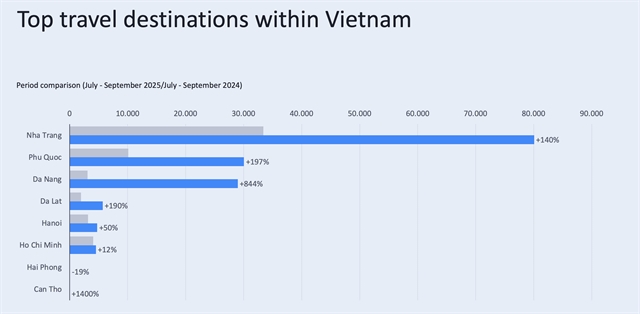 Economy
Economy


|
| Hoàng Đức Thân, former director of the Institute of International Trade and Economics under the National Economics University. |
The COVID-19 pandemic has caused many difficulties for global trade activities. Therefore, switching from traditional exports to exports based on e-commerce platforms is not only an option but is a mandatory trend to help businesses survive and develop in the difficult period. However, there are still many challenges for enterprises in implementing online export activities.
Hoàng Đức Thân, former director of the Institute of International Trade and Economics under the National Economics University, spoke to Vietnam News Agency's Vnews Television about this issue.
Online export is considered the fastest way to bring Vietnamese products to the world. What do you think about the current commercial activities of local enterprises?
Online export is a form of cross-border trade. It is a combination of traditional international trade with e-commerce.
This form has appeared since 2000 in developed countries such as the US, Canada, Japan and EU countries. Especially, thanks to Industry 4.0, online export has developed quickly.
According to statistics, countries such as the US, EU, Japan and some Asia Pacific nations had growth rates of cross-border trade doubling those of domestic trade activities.
In Việt Nam, cross-border e-commerce activities are developing in the early stages in the form of importing goods via orders on e-commerce platforms such as Amazon and Alibaba or transactions on social networks such as Facebook and Tiktok.
A number of Vietnamese enterprises have begun to export goods through e-commerce by their websites setting up links with major trading floors around the world.
Thus, Vietnamese enterprises have begun to grasp the development trend of the international trade activities.
What are the difficulties that Vietnamese businesses are likely to face when exporting goods based on e-commerce platforms?
According to the Việt Nam E-commerce Association's recent survey of more than 1,500 small and medium-sized enterprises that take part in export activities, 49 per cent of them have an e-commerce website and 11 per cent participate in e-commerce floors. However, only 2 per cent of those enterprises have signed contracts with reputable and international e-commerce platforms.
The digital transformation process is implemented slowly in import-export enterprises and international logistics enterprises, as well as businesses providing services relating to import and export activities.
Research and analysis of international markets and customers are weak. Việt Nam does not have a good database so local enterprises have depended on available market information or foreign partners when they do not have information about those partners' markets.
In addition, Vietnamese enterprises currently lack qualified personnel to meet the demand for developing online exports.
Meanwhile, State management activities for e-commerce have not been synchronised. For instance, online customs clearance is not implemented yet. The State does not have many policies on enhancing connection between domestic e-commerce with e-commerce abroad and has not yet completed regulations on e-commerce management.
What is the potential of the Vietnamese e-commerce market as well as of goods exported through e-commerce sites?
Việt Nam is located in the Asia-Pacific and this is the region with the highest growth rate of cross-border e-commerce globally with an average growth rate of about 37.7 per cent each year in the 2014-2020 period, while the global average growth was 27.4 per cent.
Việt Nam is also considered as a country with a high growth rate of domestic e-commerce in the region.
According to the latest survey of the Việt Nam E-commerce Association, e-commerce growth reached 32 per cent in 2019 and the growth rate of the whole 2016-2019 period was at 30 per cent.
Việt Nam's e-commerce market is expected to exceed $40 billion and rank third in ASEAN by 2025.
At present, Vietnamese businesses have access to e-commerce platforms, especially large and reputable ones such as Amazon and Alibaba. That will help Vietnamese businesses promote their online goods export as well as the development of cross-border e-commerce.
What should Vietnamese businesses do to promote online goods exports via e-commerce platforms?
Cross-border e-commerce is a combination of traditional international commerce activities with e-commerce, so e-commerce only supports the enterprises in the connection between buyers and sellers, exchange of market information, implementation of online marketing and many other activities.
Therefore, the enterprises still need to reorganise production, quickly implement digitalisation, and ensure the production of goods on a large scale with stability in terms of volume, quality and price.
They must also pay attention to registration of goods origin according to international standards for convenient and easy traceability.
Especially, the enterprises must sign export contracts with large and reputable international e-commerce platforms, and invest in qualified human resources.
The State must have policies that support domestic e-commerce platforms to connect with international e-commerce platforms, and for local enterprises in digital transformation.
It must continue to perfect the institution of the market economy, creating a favourable business environment for enterprises.
Especially, the Ministry of Industry and Trade needs to continue supportive programmes for Vietnamese exporters to join e-commerce trading floors.
Another thing is that enterprises providing services for import and export activities such as logistics and customs must also undertake digital transformation.
The State must encourage universities to train qualified human resources for industries, such as e-commerce, logistics and supply chain management, digital economy and digital business, to provide for the businesses. VNS